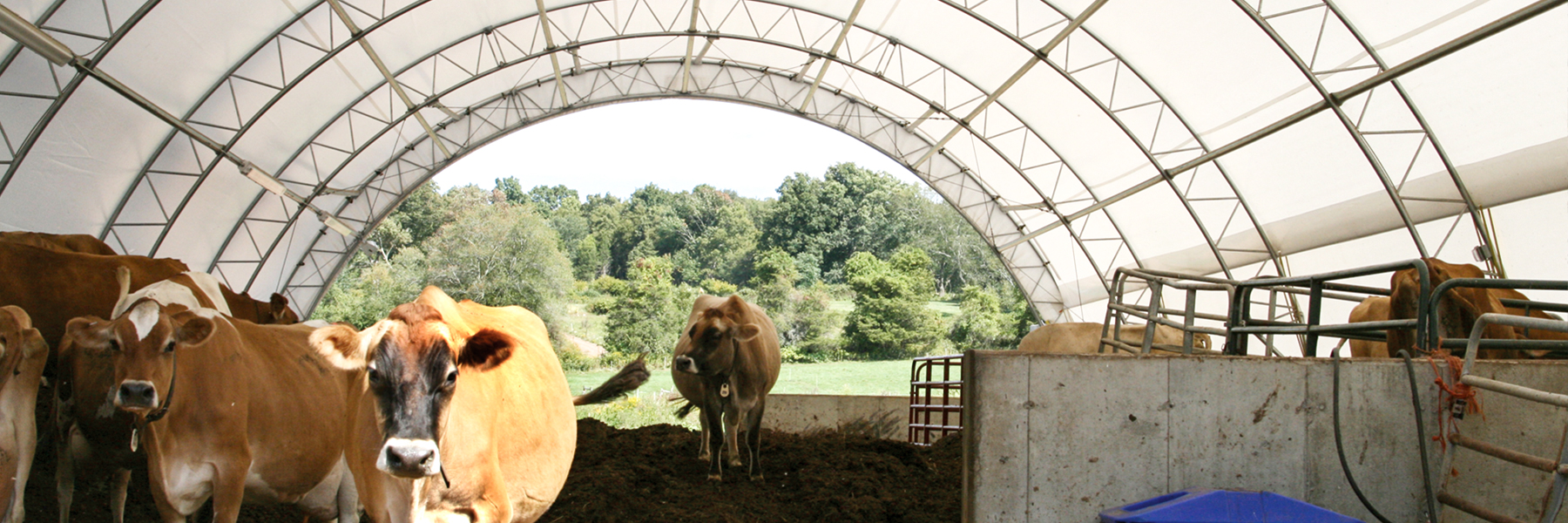Feeding Cattle During Winter
Oct. 3, 2017
With the threat of cold and wet seasonal conditions looming, cattle ranchers might find that both they and their herd can benefit from making some changes to a traditional feeding operation. Maintaining the value and quantity of feed in outdoor feeding systems has major challenges, including production loss. Production loss makes a farmer’s job more challenging and costly, but there are a few changes to feeding models that cattle ranchers can make to maintain a feed operation, including properly storing feed, managing waste and minimizing risks. An efficient feeding system can save businesses time, energy and money while benefitting herd health, as well. ClearSpan Dairy Buildings, Beef Master Systems and Monoslope Buildings are specially designed to create efficient and easy to clean spaces for cold winters.
Combating Feed Loss and Managing Waste
Fabric structures can be a great addition to an operation looking to protect its feed. Most winter feeding systems waste a significant amount of energy and can lead to a 50 percent loss of feed due to poor storage and feeding practices. Storing hay indoors helps it maintain its value much more than storing hay outside where it can easily spoil and go to waste. When hay is placed outdoors on the ground for feeding, it can easily be trampled and become wet, which devalues and rots the feed. If operations must store feed outside, it is worth keeping some inside for when the outside hay is depleted over time. ClearSpan Beef Master Systems feature a feed shield to help improve feed efficiency, protect feed from inclement weather and helps relieve stress by providing a more controlled feeding environment. But hay storage is only part of the feed equation, and managing waste is just as important to a quality feeding system.
When removing waste from a structure, try to be conscious of waste management procedures, and consider using manure as part of a nutrient management plan to improve winter pastures. This can be done by creating incentives and access for cattle to move into the field right after eating, and helps to minimize waste build up indoors and the labor of collecting and spreading manure around. Specifically, water and minerals can be set up away from the structure, helping to guide herds to pasture. There are other simple ways to minimize waste build up, for example, herds can also be fed on rotation to help manage the mess by breaking up the waste accumulated into multiple smaller feedings. Depending on individual operational needs, ClearSpan even has a metal Monoslope Building that has optional slotted floors to help keep feeding areas clean.
Risk Management
Managing risk during feeding is an important part of choosing a feeding system. The well-being of the herd is a major priority for any rancher, so it is worth knowing how different feeding systems can negatively affect herd health. Indoor feeding systems can be desirable for a few reasons, one of the greatest advantages being that they create a dry space which helps promote happier herds and higher quality feed. Luckily, ClearSpan carries feed accessories that can be included in the building design, such as slotted floors, feeding shields, stalls and virtually any other feature a cattle rancher could want. In comparison to feed protected by a structure, outdoor feeding systems require more energy from cattle to keep their body temperatures up in order to trudge through the mud. High traffic in muddy conditions create uneven ground which increases risk of injury, so bringing an operation indoors is something to consider for the well-being of the herd.
Flooring
Flooring choices can be a major factor in risk assessment of a feed operation. Luckily, ClearSpan Fabric Structures come with a variety of foundation and flooring options. Using an indoor facility for feeding in winter provides a dry space to minimize the mess and risks associated with winter pasture feeding. There are some notable problems with traditional winter pasture management, which can have significant environmental risks that require a lot of clean up. For example, poor flooring quality and materials can very easily become compacted, muddy and eroded, allowing toxic run off into nearby streams and water sources. If adding a building for winter feeding, it is best to have stable flooring that is easy to keep clean and doesn’t allow waste run off. Stable, solid flooring is not only easier to clean, but can help decrease the risk of injury to a herd or employees. Concrete or heavy use area pads for high traffic areas of the operation are very useful and help to maintain quality flooring. It is recommended that one make sure supporting soil particles are not only even, but compacted enough before pouring to avoid cracked concrete as soils shift and settle.
With a solid foundation and protection from cold and wet winters, a fabric building is an ideal space to begin to implement these feeding changes and create the perfect system. ClearSpan has been designing structures for cattle and livestock for decades and provide an environment that helps promote safety and improve health due to natural ambient light and unobstructed living quarters that do not collect dirt or moisture. Buildings can easily be outfitted with passive or mechanical ventilation systems catered to fit any particular operation, so keep in mind these feeding management tips and contact ClearSpan’s team of specialists to create an ideal building for any size herd, today.
Request a Quote to find out how ClearSpan can help your cattle operation.

